Events
Take the Microsoft Learn AI Skills Challenge
Sep 24, 11 PM - Nov 1, 11 PM
Elevate your skills in Microsoft Fabric and earn a digital badge by November 1.
Register nowThis browser is no longer supported.
Upgrade to Microsoft Edge to take advantage of the latest features, security updates, and technical support.
Important
[This topic is pre-release documentation and is subject to change.]
As data culture spreads across more and more organizations, and analytics becomes a vital part of decision making and the daily actions taken by employees, it has become critical to have reliable, up-to-date analytics readily available in your Power Apps.
As a step towards achieving this goal, it's possible to add Power BI reports and datasets as components in Power Apps solutions. Once you add a Power BI report to a solution, it can be seamlessly managed as part of your ALM process across environments and tenants.
Important
In this article, you learn how to do the following tasks:
Open your Power Apps solution development environment.
Create a new solution.
In the new solution, choose Add existing > Analytics > Power BI Report.
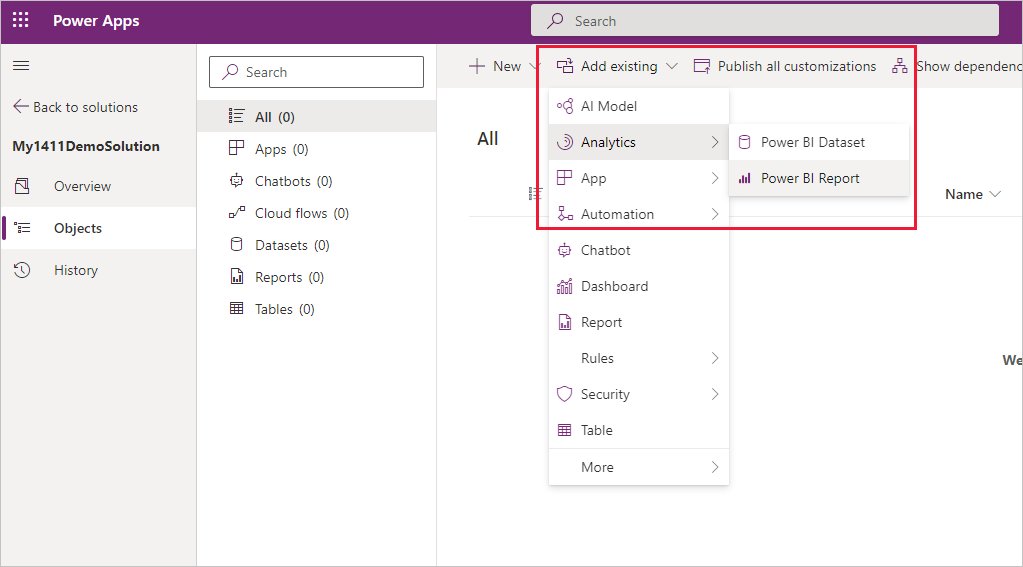
Select Outside Dataverse, find and select the Power BI report you want to add to the solution, and then choose Add.
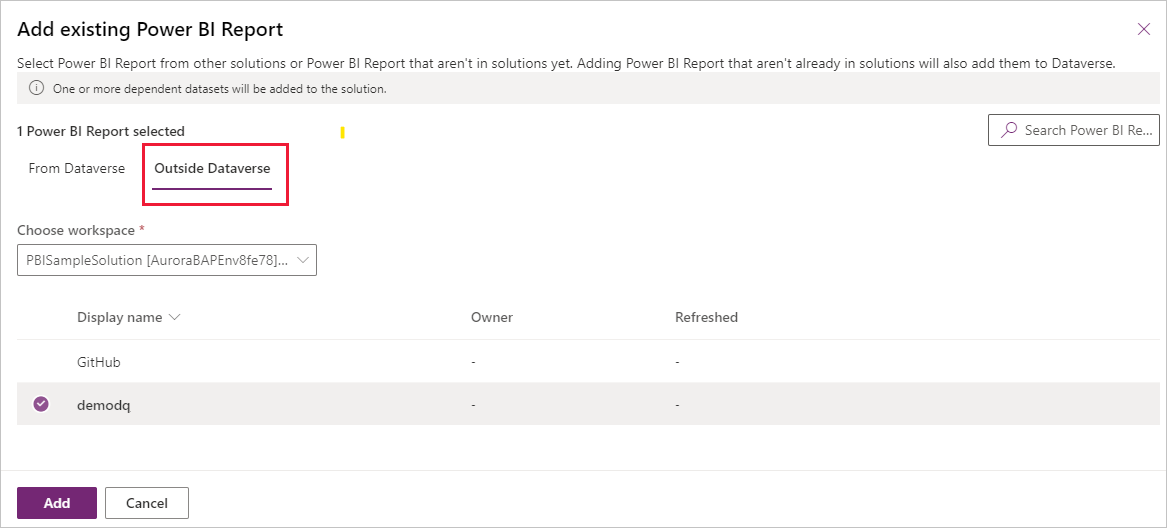
When you add a Power BI report component to a solution, a component for the report's dataset is added to the solution as well.
In addition, when you add a report from outside of Dataverse, copies of the report and its dataset are created in the workspace that is dedicated to the environment. Afterwards, all updates should start from this dedicated environment workspace.
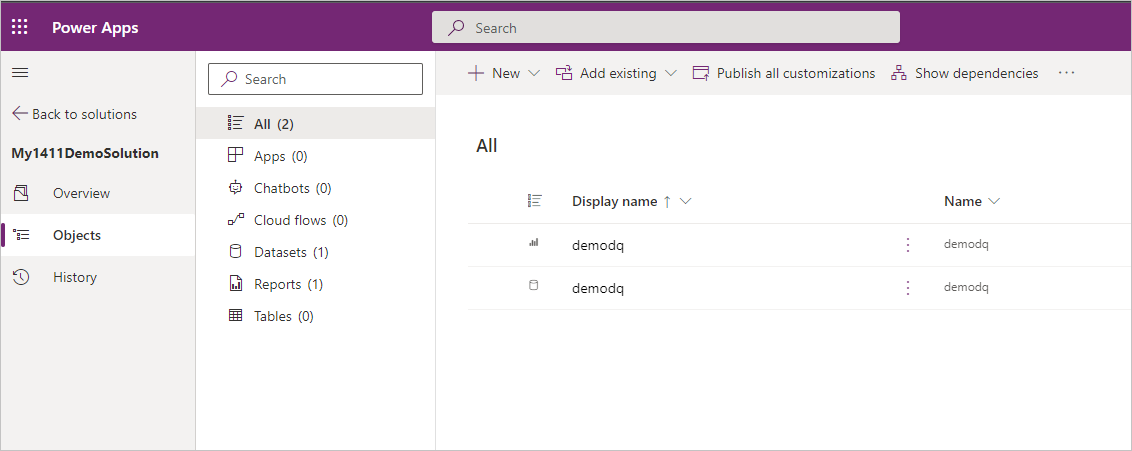
Note
The Add operation can last a few minutes while the actual reports and datasets are being exported to Dataverse.
If your dataset connects to a Dataverse data source, you can configure it to automatically connect to the Dataverse data source in deployment environments.
Select the dataset and choose Edit.
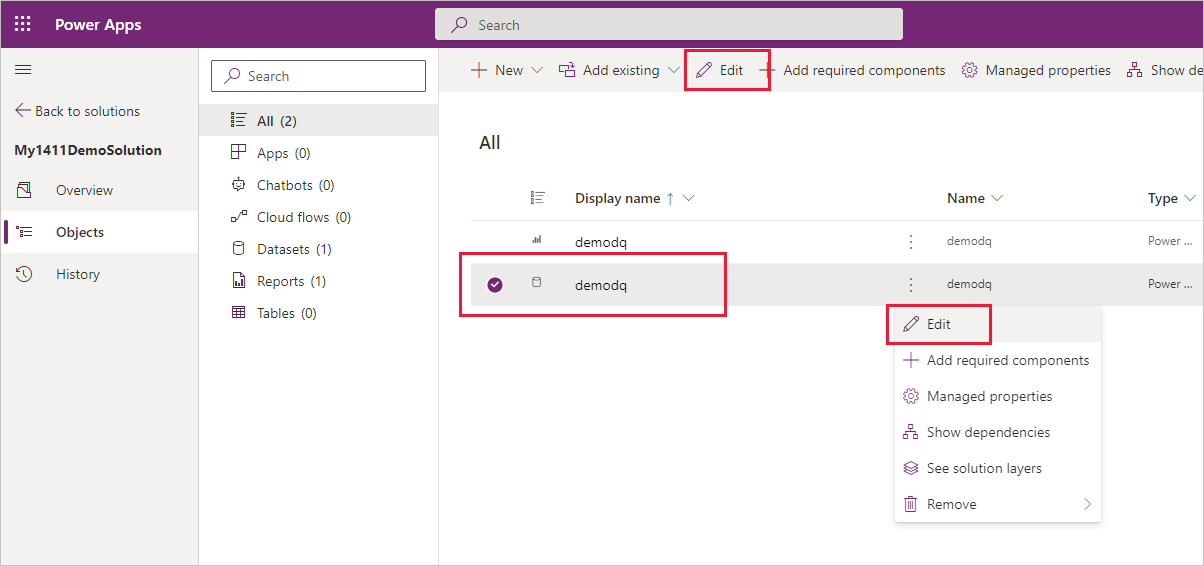
In the edit pane that appears, select Yes to configure the dataset so that it automatically connects to an existing connection when the solution is imported into another environment.
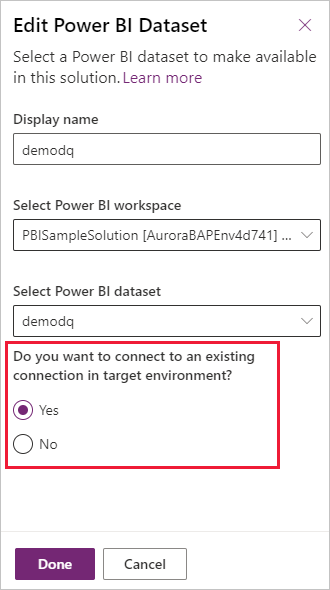
Note
Steps 5 and 6 are only relevant for Dataverse data sources.
Now, you can create a Power BI embedded system dashboard based on the report component or embed it (the report component) in a form using the form designer.
When done, export the solution. You can export the solution as either a managed or unmanaged solution.
Power BI components allow you to configure Power BI mashup parameters. However, you can't create Power BI mashup parameters in the solution environment – they must already be present in the Power BI dataset you add to the solution.
Note
The Power BI dataset parameter types Any and Binary are not supported in the Power BI integration with Power Apps solutions.
In this section the options you have for configuring how a Power BI dataset parameter is going to get its value when the solution is deployed in a different environment are displayed.
Go to your Power Apps environment > Solutions.
Create a solution.
Select the dataset that has the parameters you want to configure, and then choose Edit parameters:

Choose Add a parameter. You can only add parameters that are already part of the Power BI dataset:
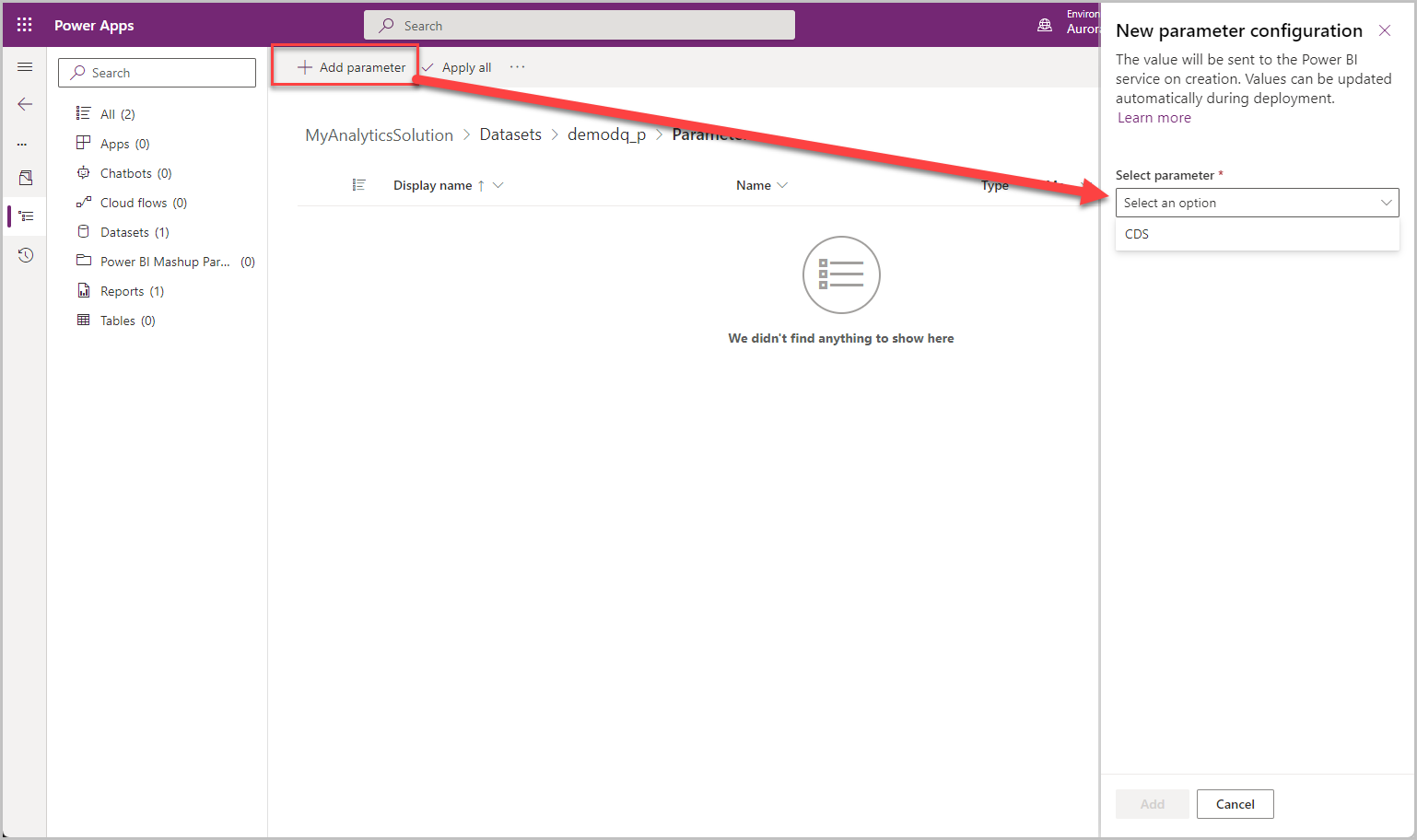
Select a Power BI mashup parameter and choose Edit to open the parameters edit pane. Select the Replace current value with * drop-down to view the parameter configuration options.

You have three options for determining how the parameter is going to get its value when the solution is installed in a different environment:
Custom text: This is the most straightforward way to set a value. When you select the custom text option, you specify a text string, and then, when the solution is deployed in another environment, that text string will be the value of the parameter.
Current environment domain: When you choose current environment domain, the value of the parameter will be domain of the current environment. This means that wherever the solution is deployed, the value of the parameter will be the domain of the deployment environment.
Environment variable: With this option you associate the parameter value with an environment variable. When you select this option, you'll notice all the environment variables in the current environment, and you can select one. If the environment variable you need doesn't exist, you can create one in the solution.
The environment variable option is significant because it makes it possible to require the installer to provide a value for a parameter during deployment. This is done by associating the parameter with an environment variable that has a blank value.
When you configure a parameter with an environment variable in order to require the installer to provide a value upon deployment, make sure that the default value is blank. If there's a current value, remove it by right-clicking and choosing Remove from solution.
For more information about environment variables, go to Environment variables overview.
Once you're done configuring the parameters, select Apply all to apply all parameter values.
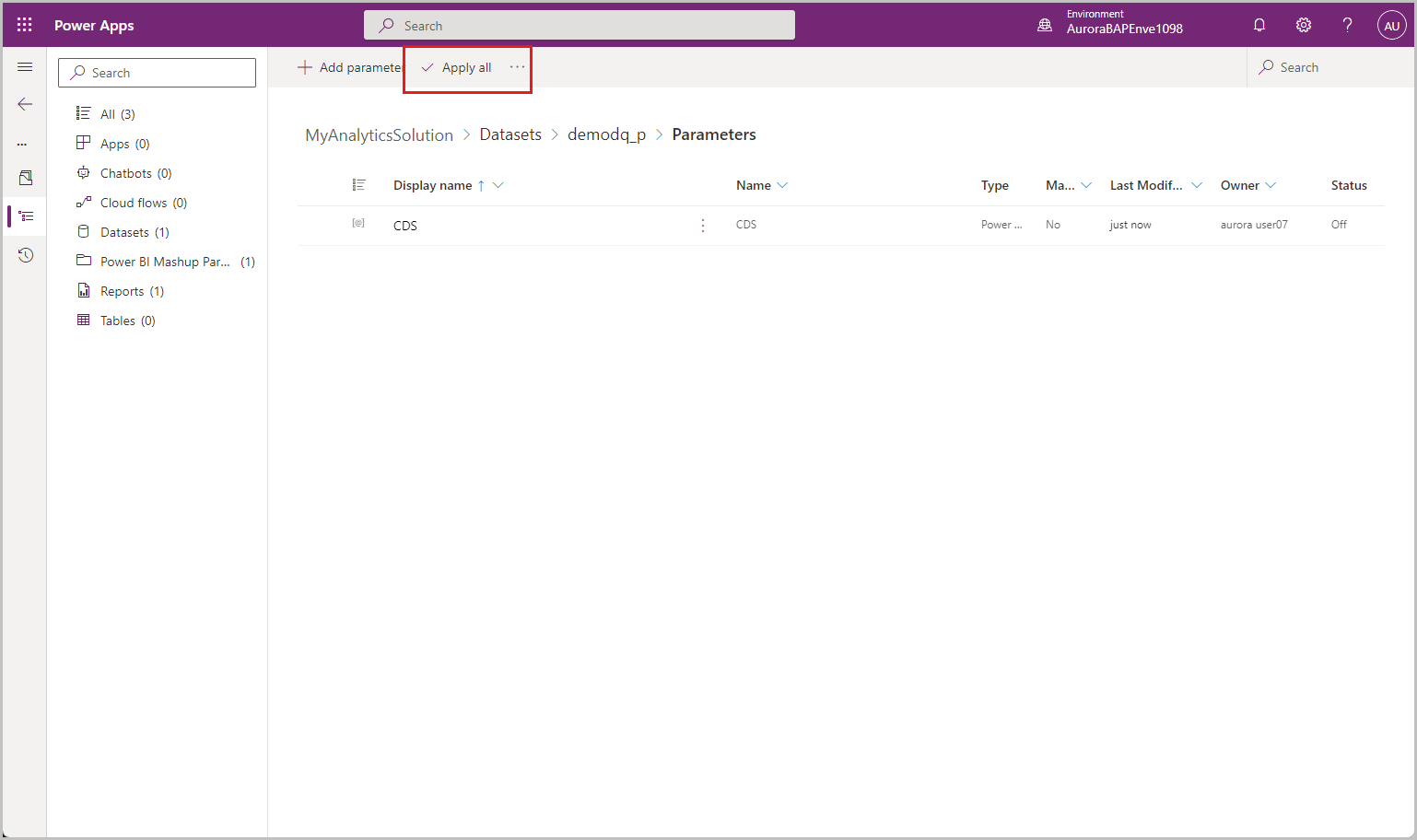
Once you’re applied the parameters, you can export the solution and deploy it in your deployment environments.
Updates to Power BI components must be made in Power BI on the artifacts in the dedicated Power BI environment workspace that are connected to the components. You can access these artifacts either by opening the workspace directly in the Power BI service, or by using the Open in Power BI option in the Power Apps environment.
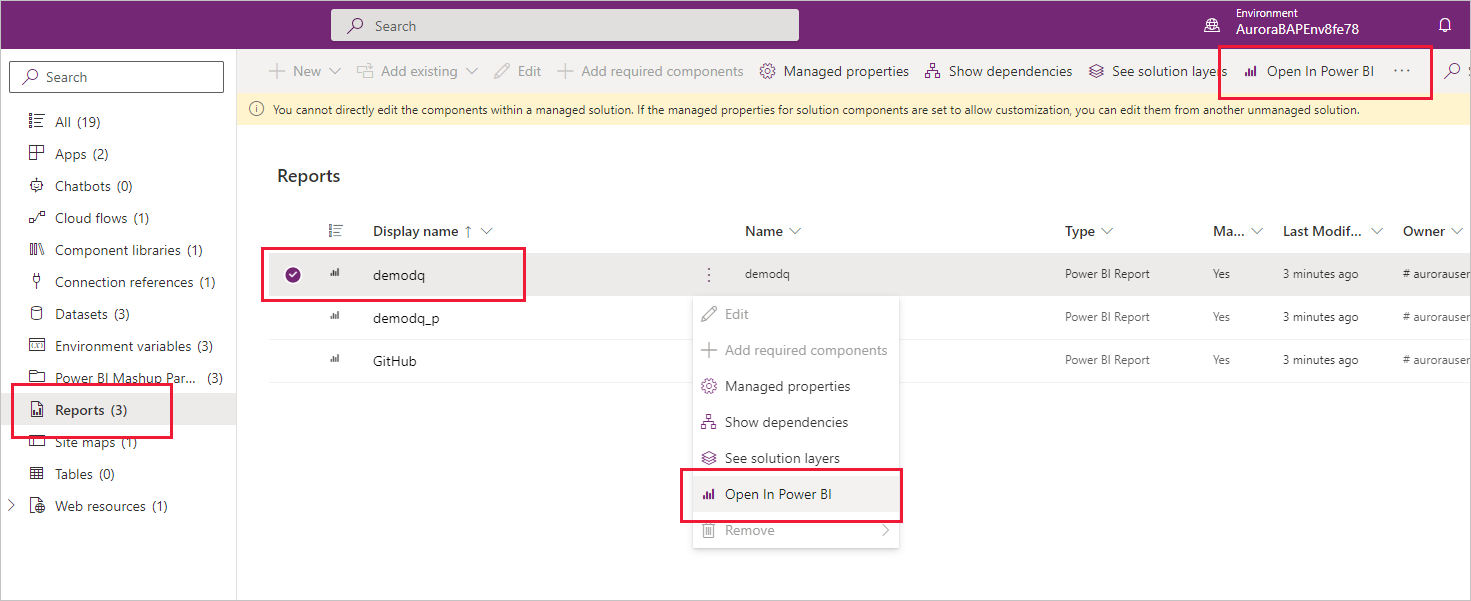
Note
Updating a solution with Power BI components automatically updates the relevant artifacts of the dedicated environment workspace in Power BI for both managed and unmanaged solutions.
After you update the component, you can export the solution as a managed or unmanaged solution, and then import it into a different environment (for unmanaged solutions you can also import into the same environment).
Events
Take the Microsoft Learn AI Skills Challenge
Sep 24, 11 PM - Nov 1, 11 PM
Elevate your skills in Microsoft Fabric and earn a digital badge by November 1.
Register nowTraining
Learning path
Embed Power BI analytics - Training
This learning path teaches you how to embed Power BI content in apps, develop programmatic solutions using the Power BI REST API and the Power BI Client APIs, enforce row-level security (RLS) for embedded content, automate common Power BI setup tasks, configure a development environment, and determine appropriate licensing.
Certification
Microsoft Certified: Power BI Data Analyst Associate - Certifications
Demonstrate methods and best practices that align with business and technical requirements for modeling, visualizing, and analyzing data with Microsoft Power BI.